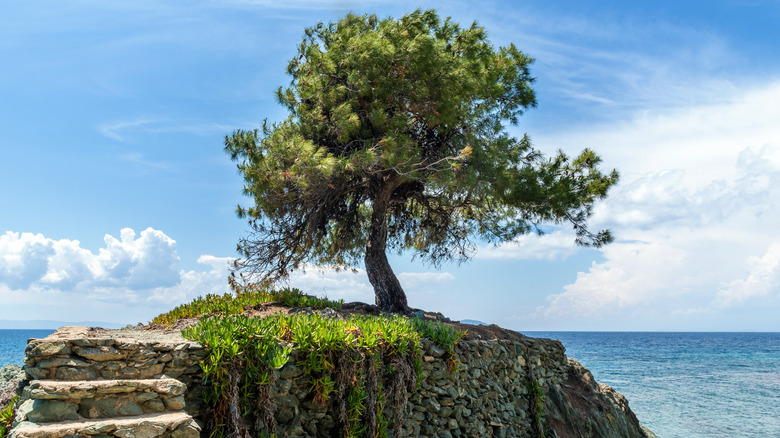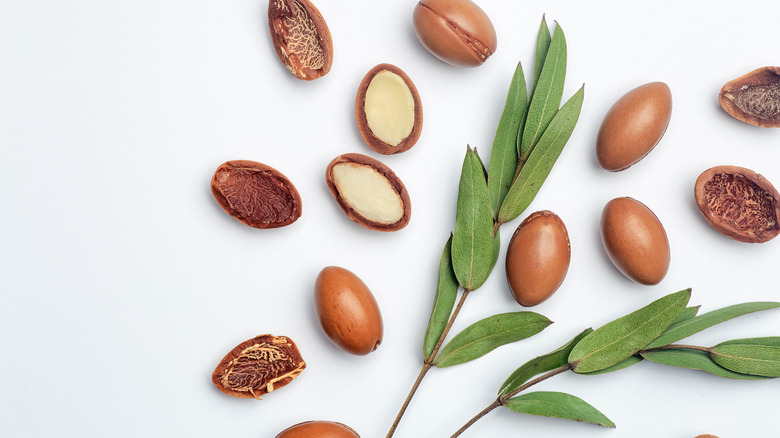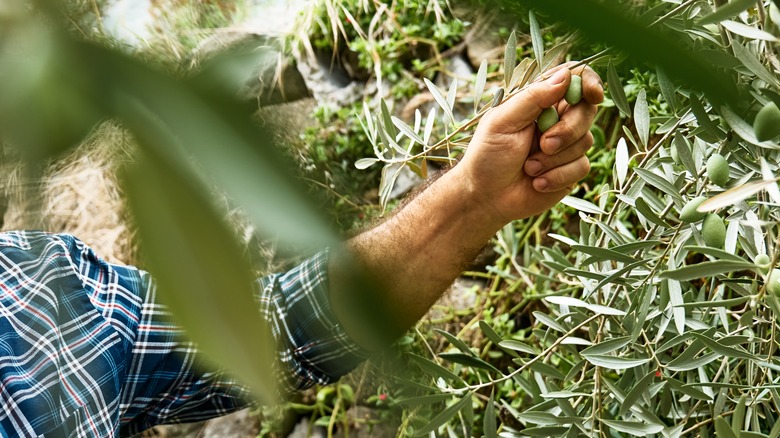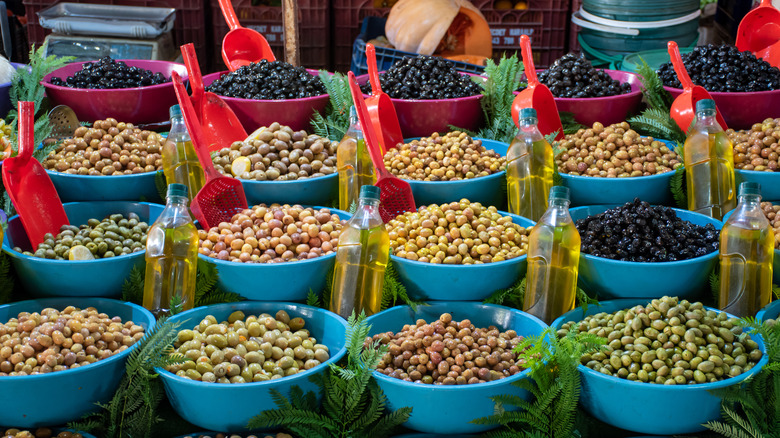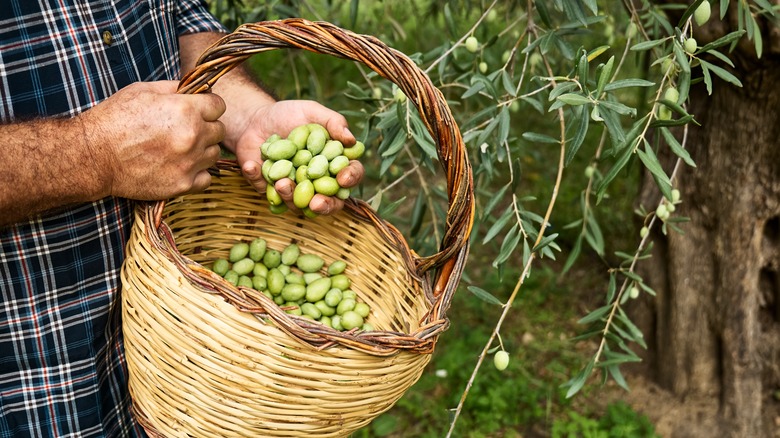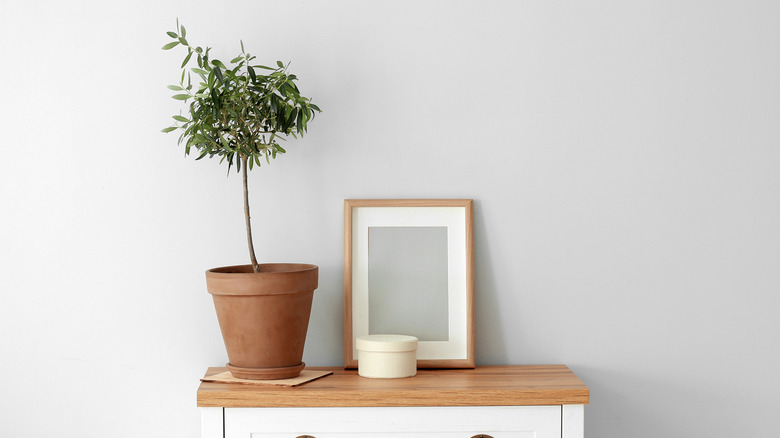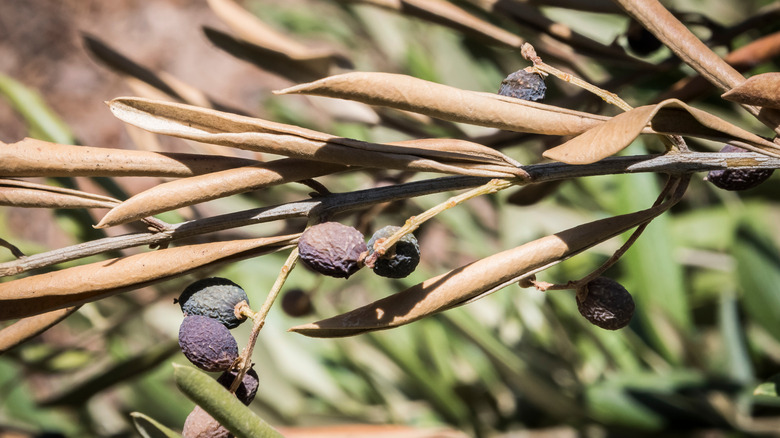How To Grow And Care For Olive Trees
If you want to add a traditional or symbolic aspect to your garden, the olive tree is the perfect plant. Olive trees originated in Asia Minor, which is around the area of Turkey today. From there, they spread quickly across the Mediterranean to parts of northern Africa and southern Europe, International Olive Council notes. For instance, the olive tree continues to thrive in Greece and provides significant importance to the surrounding community. The people of Greece praised the olive tree because it symbolizes peace, wisdom, fertility, prosperity, health, luck, victory, stability, and tranquility. The tree made its way into many Greek cultural traditions and continues to give essential products to people. They are extraordinary shrubs that are even said to date back before the existence of mankind, as per Mykonos Olive Oil Tasting.
Garden Guides states that olive trees are evergreen shrubs that love the sea and sunshine. They can be identified by their brown, knobby twisted trunk and flat, oval-shaped leaves. The top of each leaf is a deep green-gray color, while the bottom is a lighter green-silver color. Each leaf is very thick and has a leathery texture. Olive trees are not difficult to grow or maintain, but they require patience throughout the process, Four Winds Growers says. If you are ready to take on this symbolic slow-growing tree, here's everything you need to know to start growing and caring for your new olive tree.
How to grow olive trees
Prepare for a relatively long process if you plan to germinate your own olive trees, and although an olive seed takes at least forty days to germinate, it is easy to initiate. First, ensure you select a self-pollinating variety and a seed that comes straight from the tree if you want your singular tree to bear fruit, Hunker advises. Also, the fruit should not be processed before removing the seed. Remove the pit and let it dry out for a few days before breaking it open and extracting the seed. As per the YouTube channel From Seed, the grain is located inside the pit, at the center of the fruit. Next, place the seed two inches deep inside a container filled with well-draining potting soil. Place the pot in the sun and water it daily as it undergoes germination.
When propagating your olive tree, take an 8-inch cutting from a healthy portion of your tree. First, trim the lower 2/3 of your cutting by clearing it of leaves and any connecting branches. Next, stick the lower end of the cutting in some root growth hormone and immediately place that end of the cutting in a fresh pot of soil. You should firmly pat the soil down to allow the clipping to stand-up straight. Keep the soil moist and mist the leaves frequently as the roots develop, Garden Knocks suggests.
How to care for olive trees
Olive trees are low-maintenance shrubs, but they still require several things to thrive. First and foremost, these florae need well-draining soil due to their demand for dryer grounds. Avoid planting the tree in a soggy environment or where water tends to stand for long periods; however, although they prefer dryer soil, don't let your olive tree stay dry for extended periods, Olive Tree Growers advises. La Résidence recommends checking your tree's soil every week to avoid overwatering your plant. When the top two inches of soil are dry, give your tree about four cups of water. Sunshine, however, will always be welcomed by your olive tree. Olive trees love sunshine; therefore, keep them in a full-sun position where they receive at least six hours of direct sunlight a day.
Olive trees don't need any special fertilizer to grow; however, using it proves to have stunning results. Find a balanced, slow-release fertilizer for the best results, and fertilize your tree twice a month during spring, summer, and fall. Pruning can also be done to continue the ongoing health of your olive tree. Avoid pruning the first two years of purchasing or germinating the plant; however, when you do it, always prune between the end of winter and the start of the flowering season. Also, ensure you limit this process to yellow, dead, or diseased parts of your tree.
Olive tree varieties
Similar to other types of plants, there are also many olive trees to choose from. Based on what you want to bring to your garden and the environment you live in, you can choose an olive tree that works best for you and your backyard. The Spruce shares a variety of popular olive trees that specifically bear fruit. Yardzen also shares a variety of olive trees that do not bear fruit, bringing the same beauty to your yard without the mess or hassle of dealing with the fruit.
- Arbequina olive tree — This olive tree type originates from Spain and thrives as a potted plant.
- Mission olive tree — This tree is great for bearing fruit in colder environments.
- Niçoise olive tree — This is also a popular variety of fruit-bearing shrubs to pick from based on their fruit uses and taste.
- Wilsonii olive tree — This type does not bear fruit but still adds beauty to your yard with its unique twisted trunk and grey-green leaves.
- Chemlali olive tree — This lesser-known olive tree is the most compact variety here, making it an excellent option for smaller yards. This tree is primarily used for olive oil.
Are olive trees toxic?
Olives trees have never been proven to be toxic to humans or any species of animal; in fact, they can add an edible touch to your home garden, as Hunker notes. However, be aware that look-alike olive shrubs, which have little to no connections to real olive trees, may be toxic to consume for both humans and animals.
Most olive trees produce fruit known as olives. Tree Journey mentions that although raw olives are not commonly enjoyed because of their bitter taste, they make a widely appreciated snack once processed. The fruit is also used to make one of the most commonly used kitchen oils, olive oil. The leaves of an olive tree also have a range of health benefits when eaten in small amounts: They contain a significant quantity of antioxidants, which can act as a defense against diseases and raise immunity. Consuming the leaves regularly can also result in improved brain functions and prevent health problems like diabetes and cancer, Medical News Today notes. They are most commonly chewed or dried and mixed into teas.
How to repot olive trees
As mentioned before, olive trees are slow-growing shrubs, which means they do not need to be repotted very often. Daisy Dawes states because olive trees stay in the same pot for a while before being moved, they may cling to the container. If your olive tree is clingy, drive a knife around the inside edge of the pot to loosen up the plant's roots, then tip the pot to the side and gently drive the tree out of the container.
When choosing a new pot for your olive tree, ensure it is wider rather than deeper because these shrubs naturally have shallow roots. Daisy Dawes also mentions that because olive trees prefer dryer soil, you can use clay pots to help draw some of the moisture out of the soil. Furthermore, you can purchase specific soil mixtures for plants that prefer dryer soil. As you place the tree in its new pot, break off some of the old soil and loosen up the roots to help them continue their outward growth. When the tree is in its new place, fill in fresh soil around the roots and pour in some water to help them settle. Let the tree recover in indirect sunlight for a few days before placing it back in its full-sun position.
Olive trees as houseplants
As houseplants continue to trend, it is not uncommon to find olive trees thriving in indoor environments. Apartment Therapy states that olive trees accompany modern home designs perfectly with their green-grey foliage against lightly colored surroundings. However, when growing an olive tree inside, it is still important to keep their needs in mind. Regardless of whether they are kept indoors or outdoor, olive trees need as much sun as possible; therefore, the best place to put them would be against a sunny south-facing window. Never keep them in a dark area of your house.
Even though olive trees are slow-growing, they can reach pretty tall heights, so it would be best to bring only dwarf olive trees into your home if you don't have a particularly tall ceiling. Similar to outdoor olive trees, also ensure your shrubs always have proper drainage and receive the right amount of water. To properly water your olive tree, allow the first 2 inches of soil dry out completely before rewatering, but don't let the soil stay dry for too long before giving it to drink. Olive trees are not desert plants; therefore, they can not withstand extremely dry environments.
Common problems for olive trees
Olive trees are most commonly affected by fungal diseases, like Verticillium wilt. This disease causes a decrease in foliage and even has the potential to kill the entire tree. Peacock spot disease is another common fungal disease that can affect the tree's leaves, usually brought on by cool and humid conditions. Pests like olive moths can have a habit of attacking olive trees as well; these pests tend to feed on the tree's fruit and flowers, causing the premature dropping of produce.
Garden Guides suggests keeping your tree healthy with the right amount of water, nutrients, and conditions to reduce your tree's susceptibility to these pests, fungal diseases, and other health issues. Also, avoid pruning away diseased parts of the tree in the month of fall to prevent winter damage to your tree due to the lack of new growth during that time. Pesticides, bactericides, and fungicides can be applied in the spring and fall to control pests and diseases, but always avoid using these solutions before harvest time for the best results.
